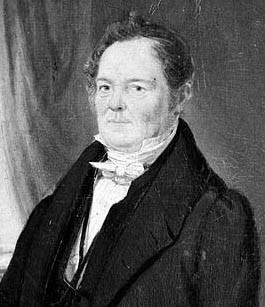Name George Evans | Role Explorer | |
 | ||
Died October 16, 1852, Hobart, Australia | ||
George William Evans (5 January 1780 – 16 October 1852) was a surveyor and early explorer in the colony of New South Wales. Evans was born in Warwick, England, migrating to Australia in October 1802.
Contents
- Early career
- Exploration of the inland
- Later life and death
- Other activities
- Memorials to Evans
- References

Early career
In 1803, Evans was appointed acting Surveyor General of New South Wales whilst Charles Grimes was on leave in England. In 1804, Evans explored the Warragamba River and upstream to the present site of the Warragamba Dam. Later removed from the position by Governor Philip Gidley King he was posted to the position of Assistant Surveyor by Lieutenant-Governor William Paterson. Evans surveyed the shores of Jervis Bay and inland to Appin leading the way to the settlement of the Illawarra region. Probably because of his success it was Governor Lachlan Macquarie who instructed him to find a passage to the west.
Exploration of the inland
On 13 November 1813 Governor Lachlan Macquarie sent Evans across the Blue Mountains into the Wiradjuri nation of central-western New South Wales to confirm the findings of the exploration party of Blaxland, Lawson, and Wentworth. He was the first European to record meeting with the Wiradjuri people of the region. Evans generally followed the route of Blaxland, Lawson and Wentworth, reaching the end of their route on 26 November 1813 at a point and had Evans named Mount Blaxland. Evan's party then moved on and discovered the Fish River area and further west near the junction of the now named Fish and Campbell Rivers and described two plains in his view, the O'Connell Plains and the Macquarie Plains. It was on 9 December that he reached the site of present-day Bathurst.
After the explorations that took seven weeks Governor Macquarie awarded Evans ₤100 and 1000 acres of land near Richmond in Van Diemens Land (Tasmania). Evans departed for Tasmania in 1814 but was back in NSW by 1815 to continue inland explorations.
In 1815, Evans was the first colonial explorer to enter the Lachlan Valley, naming the area the Oxley Plains after his superior the surveyor-general, John Oxley. He also discovered the Abercrombie and Belubula River Valleys. He was the first explorer through the areas that now include the towns of Boorowa and Cowra.
On 1 June 1815 in Eugowra, a town in the Central West region of New South Wales, George William Evans and his group marked a tree at the junction of Lachlan river and a creek which they named Byrnes Creek. This was the furthest west any Europeans had travelled into the country.
On 1 June 1815 he was running short of provisions and returned to Bathurst where he arrived on 12 June. This journey opened the way for later explorations, mainly by John Oxley. Evans took part in some of Oxley’s expeditions.
Evans returned to Tasmania in 1817 but was again to return to New South Wales to journey with his superior John Oxley on travels into the Lachlan River areas, along the path of the Macquarie River to the Macquarie Marshes and eastwards to the coast to Port Macquarie.
Later life and death
Accusations were made about irregular payments made to Evans whilst in the Surveyor-General's position and he was despatched by ship to England to explain the matter to Lord Bathurst, Secretary of State for War and the Colonies. He sailed for England on 14 November 1826. It appears Lieutenant-Governor George Arthur found it difficult to positively prove the accusations with a general loose attitude to payments within that office. Arthur even supported Evans' request for a retirement pension. Evans returned to New South Wales about six years later and was shown as a stationer / bookseller in Bridge Street, Sydney. The last ten years of his life was spent at Hobart, Tasmania, where he died on 16 October 1852. Evans' and his wife Lucy Parris' headstone is at St Andrew's Anglican Church, Evandale, moved from St John's Church, Newtown, Hobart, Tasmania
Other activities
Evans was known as an artist of some note, some of his aquatints are held at the Dixson Library of New South Wales. He was also a teacher at King's School, an independent Anglican boarding school for boys in North Parramatta in the western suburbs of Sydney, Australia. Founded in 1831, it is Australia's oldest independent school.
Memorials to Evans
A standing bronze portrait on a large rusticated sandstone plinth of Evans is located in Kings Parade (Park) at Bathurst in the Central Tablelands region of inland New South Wales. The memorial was built in 1913 by the citizens of Bathurst to commemorate the 100 years since his discovery of the Bathurst region.
